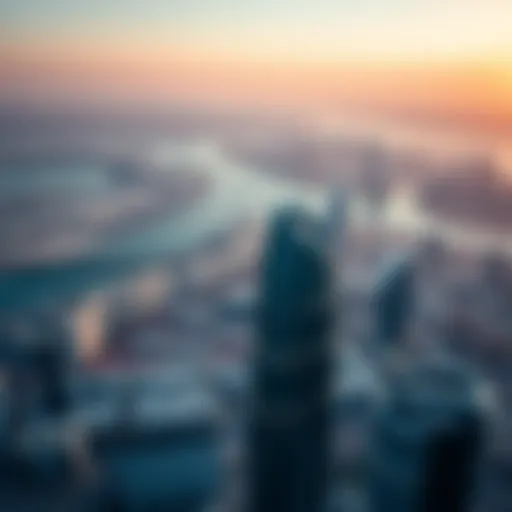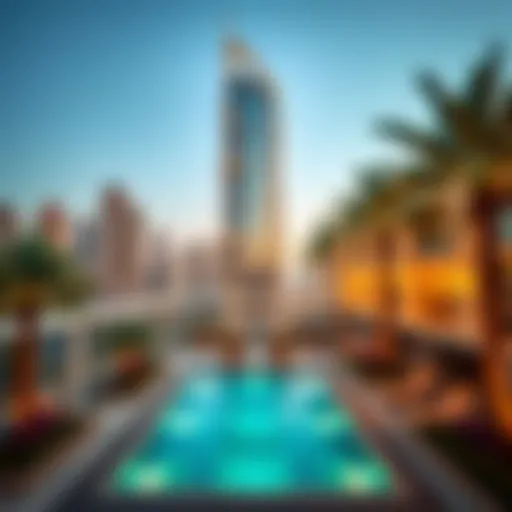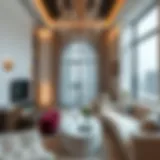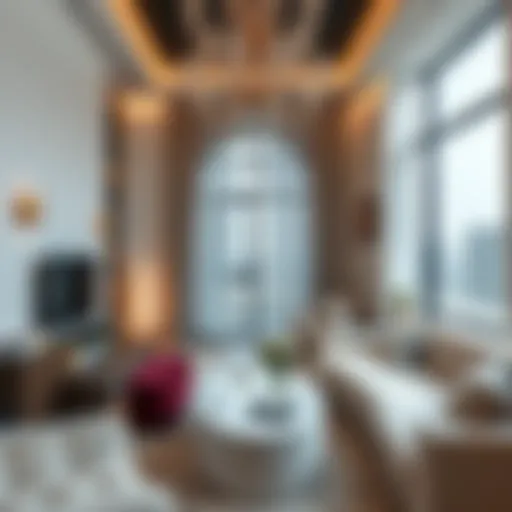Exploring the Red Line of Dubai Metro: A Transport Revolution
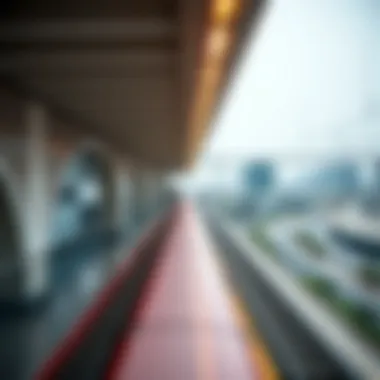
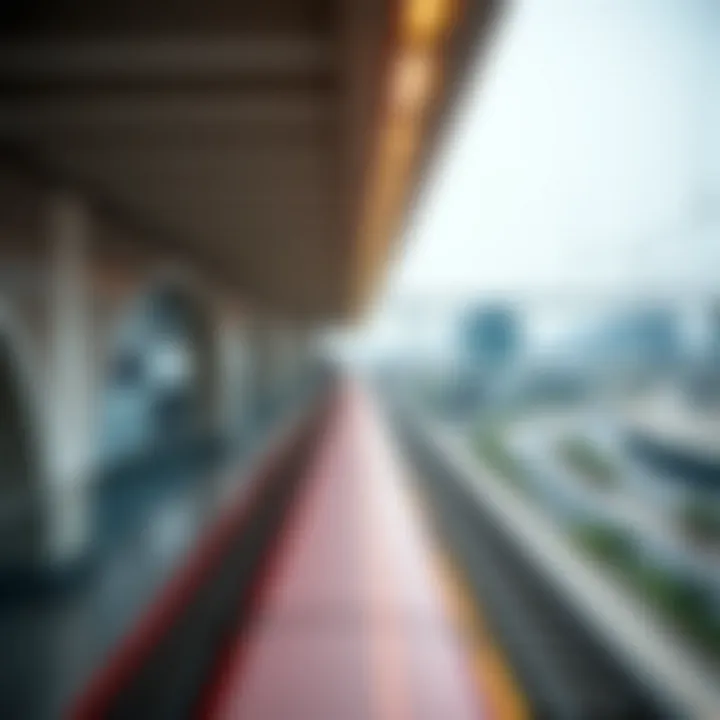
Intro
The Red Line of Dubai Metro represents more than just a means of transport; it symbolizes a leap toward modernity and urban efficiency in one of the world’s fastest-growing cities. With its launch in 2009, this metro line seamlessly connects Dubai's bustling hubs, showcasing how public transport can enhance both mobility and economic landscapes. As we explore the Red Line, we will uncover its features, operational significance, influence on real estate, and what the future holds. This journey will provide a thorough understanding of the integral role that the Red Line plays in shaping urban life and investment dynamics in Dubai.
Market Trends
Current Market Analysis
Dubai's real estate market has been on a rollercoaster ride, driven notably by developments linked to the Red Line. With its strategic stations positioned near key commercial zones and residential areas, the line has seen an uptick in property demand. Investors, especially expatriates and local brokers, have recognized the value found in areas adjacent to the metro stations.
- Key Findings:
- Increased property values in areas like Dubai Marina and Downtown Dubai.
- A notable influx of expats attracted to easily accessible housing options.
- Enhanced commercial viability for businesses near metro stations.
The connectivity provided by the Red Line is pivotal in attracting not only residents but also tourists, creating a vibrant economic atmosphere.
Future Projections
Looking ahead, the future projections for the Red Line appear promising. With plans to extend the line and maintain upgrades, it is anticipated that more areas will benefit from this enhanced connectivity.
- Future Developments Expected:
- Expansion towards Expo 2020 venue and further residential developments.
- Introduction of smarter technologies aimed at improving passenger experience.
- Collaborations with private sectors for mixed-use developments around stations.
According to industry experts, the development linked to the Red Line is poised to play a critical role in the success of upcoming urban projects.
"The Red Line not only serves as a transport route but also acts as a lifeline, breathing new life into neighborhoods and commercial spots."
—— Real Estate Analyst, Dubai
Investment Opportunities
High-Growth Areas
Investors should keep an eye on Dubai Healthcare City and Al Jaddaf, which are emerging as high-growth areas due to the proximity to metro stations. These neighborhoods are expected to see significant appreciation in property values as the Red Line continues to evolve.
- Notable Developments:
- Luxury apartment projects in Dubai Marina.
- Growth of commercial spaces near Burj Khalifa station.
Each of these areas is being developed with the prospect of increased foot traffic and accessibility in mind, positioning them as prime targets for investment.
Key Investment Strategies
To capitalize on the opportunities presented by the Red Line, investors should consider the following strategies:
- Research Thoroughly: Understand the current market conditions and upcoming developments in the vicinity of stations.
- Timing It Right: Invest now as property prices are predicted to rise with further developments.
- Diversify Investments: Look into both residential and commercial properties to mitigate risks.
The strategic movements resulting from the Red Line's expansion offer a rich landscape for savvy investors looking to make a mark in Dubai.
Resources for Further Exploration
- Dubai Roads and Transport Authority
- Wikipedia's Overview of Metro in Dubai
- Investopedia on Urban Development Trends
- Britannica on Transportation in Dubai
By understanding the constellation of influences surrounding the Red Line, investors and stakeholders can make informed decisions that capitalize on the robust growth narrative of Dubai's evolving urban landscape.
Preface to the Dubai Metro Red Line
The Dubai Metro Red Line stands as a symbol of the United Arab Emirates’ forward-thinking approach to urban transportation. Initiated in a city known for its rapid growth and modernization, the Red Line is more than just a transit system; it’s a lifeline for residents and visitors alike. It signifies the city’s commitment to sustainable transport solutions while simultaneously shaping the landscape of urban mobility and real estate opportunities.
The Red Line stretches from Rashidiya in the east to UAE Exchange in the west, spanning approximately 52 kilometers. It connects key districts and neighborhoods, making it a fundamental part of daily commutes for thousands. The importance of this metro line cannot be overstated; it drastically reduces journey times, alleviates road congestion, and enhances the overall commuting experience in a bustling metropolis.
Historical Context
Work on the Dubai Metro began in the early 2000s, reflecting the ambitious vision of the Dubai Government to create an efficient public transportation system in response to the growing population and increasing urban sprawl. The rationale behind this project was straightforward: with the population projected to double within a decade, a viable public transport system was essential. Hence, the Dubai Roads and Transport Authority (RTA) initiated studies and plans that laid the groundwork for what would become the Red Line.
When it opened to the public on September 9, 2009, the Red Line transformed the mobility of Dubai's commuters. At that time, it was the longest automated metro system in the world, showcasing cutting-edge technology and setting benchmarks in construction and planning. The project not only showcased technological advancements but also emphasized the cultural integration of the UAE, blending modern engineering with the city's unique identity.
Construction Milestones
The construction of the Red Line was marked by several significant milestones that highlight the complexities of urban infrastructure development. Here are some key points in the construction timeline:
- 2005: Groundbreaking ceremonies were held, officially commencing the construction of the Red Line.
- 2006-2009: Rapid construction took place, including challenges faced due to the extreme weather conditions of Dubai, which necessitated innovative engineering solutions. The construction involved some 45,000 workers and numerous machines to ensure the project stayed on course.
- 2009: The line was inaugurated, ready for its first passengers. The event itself was a grand showcase, attended by Sheikh Mohammed bin Rashid Al Maktoum, the Vice President and Prime Minister of the UAE.
The construction process demonstrated impressive project management and engineering prowess, with the use of advanced technologies, including the most modern tunneling methods. The Red Line's successful launch marked a turning point for public transport in the region and drew interest from other nations aiming to develop similar infrastructure.
As we continue to explore the finer details in the subsequent sections, it becomes evident that the Red Line is much more than a transit option; it is a key influencer in Dubai’s urban planning and economic viability.
Technical Specifications of the Red Line
The technical specifications of the Red Line are crucial in understanding its role as a backbone of Dubai's public transportation system. This section breaks down significant elements like track length and train specifications, which contribute to the operational efficiency and safety of the Metro service. These specifics matter not just for daily commuters but also for investors, real estate brokers, and other stakeholders who rely on a smooth-running transit system to propel economic growth in Dubai.
Track Length and Route
The Red Line stretches approximately 52.1 kilometers, making it a vital link across the Emirate. Starting from the Ras Al Khor area to the lavish Dubai Marina, this track weaves through prominent neighborhoods, key business districts, and tourist attractions. The route serves several strategic stops, catering to both residents and visitors alike. For instance, major stations such as Burj Khalifa/Dubai Mall, Bujuman, and the iconic Dubai Marina provide easy access to landmarks vital to the city’s cultural and economic landscape.
- Key Highlights of the Route:
- Diverse Key Stops: Each station is a gateway to bustling areas and serves as a hub of activity.
- Accessibility: Designed to facilitate movement, the track is aligned with key urban areas, helping to minimize travel time considerably.
- Intermodal Connections: The line integrates with other transport modes like buses and taxis, enhancing overall mobility.
Interestingly, the chosen route aims to lessen the dependency on cars, thus potentially decreasing traffic congestion.
Train Specifications
The trains operating on Dubai’s Red Line are a marvel of modern engineering. Each coach accommodates about 200 passengers and is designed to provide a comfortable, efficient, and safe travel environment. They run on a fully automated system, which means no drivers are actively controlling the trains. This not only improves operational efficiency but also enhances safety protocols since automated systems can minimize human error.
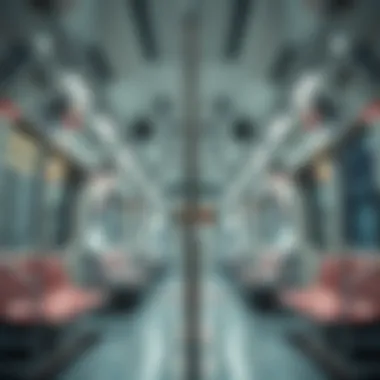
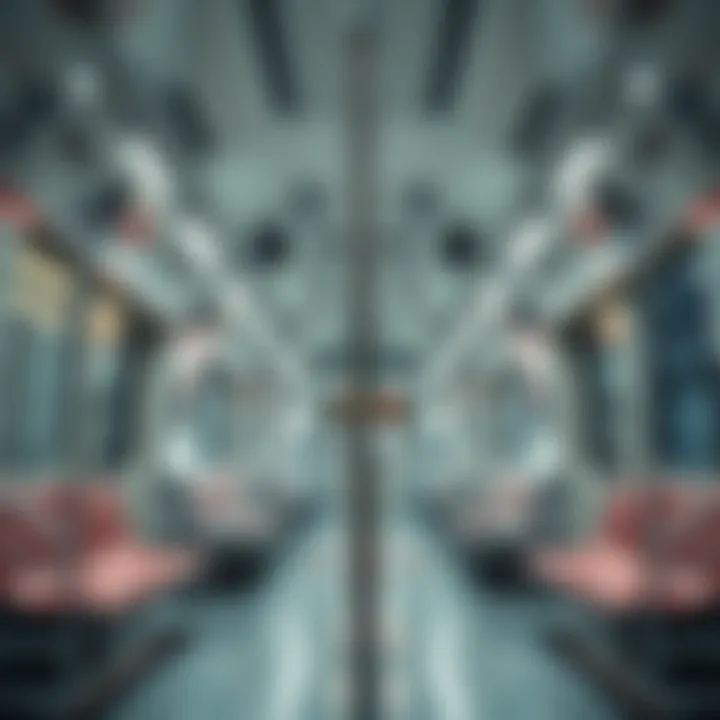
- Train Features:
- Capacity: The trains can hold significant numbers during peak hours, ensuring that commuters are not left waiting.
- Comfort and Design: Trains come with spacious seating, air-conditioning, and designated areas for luggage, making travel pleasant.
- Sustainability: Utilizing energy-efficient technologies, the Red Line trains contribute positively to the environment by minimizing carbon emissions.
The specifications of both the track and the trains play a pivotal role in how the Red Line enhances urban mobility, shaping not only transport efficiency but also real estate development around the stations.
Major Stations Along the Red Line
The Dubai Metro Red Line is iconic, not just for its engineering marvel but for the crucial role its stations play in the daily lives of thousands. This section dives into the major stations along the line, highlighting their significance, location-related benefits, and the amenities they offer, which all elevate the passenger experience. Each station is a gateway to Dubai’s rich culture, business districts, and lifestyle offerings. Understanding these stations is not just useful for commuters, but also critical for investors and businesses looking to tap into the vibrant urban landscape that surrounds them.
Key Station Landmarks
When traversing the Red Line, several stations stand out not only as transit points but also as landmarks that embody the spirit of Dubai.
- Burj Khalifa/Dubai Mall Station: Situated near the world's tallest building, this station is a hub for tourists and residents alike. The easy access to the Dubai Mall, a retail behemoth, enhances foot traffic. Visitors can indulge in world-class shopping, dining, and entertainment, making this station a focal point for anyone in town.
- Dubai Marina Station: Nestled in an upscale neighborhood, Dubai Marina is famous for its waterfront views and luxurious lifestyle. The station connects commuters to a myriad of leisure activities, from beach clubs to high-end restaurants, making it a desirable stop for both locals and tourists.
- Deira City Centre Station: An essential stop for many, Deira City Centre is close to a major shopping complex. This station typically buzzes with activity, providing passengers a connection to various local markets and cultural sites that reflect Dubai's diverse population.
These stations are not just places to catch a train; they’re dynamic spaces that reflect the city's vibrancy.
Interchange Stations
Interchange stations on the Red Line serve as critical junctions, linking various transport modalities and expanding accessibility across the city. These hubs enhance the entire public transport experience and provide a seamless transition from one route to another.
- Union Station: This is perhaps the most crucial interchange. It connects the Red Line to the Green Line, allowing for easy transfers between different areas of the city. The station is strategically located within the historic district, blending the old with the new, and is close to several attractions.
- Burjuman Station: Another key interchange, Burjuman connects the Red Line with the Green Line and sits near several shopping hubs. The station integrates multiple transit options, creating a convergence point for diverse passenger flows.
- Rashidiya Station: This station not only serves as a terminal for the Red Line but also connects to the city’s schools and hospitals. Its location ensures that residents in the outlying suburbs can access critical services easily.
Understanding the interchange stations is essential for grasping how the Red Line integrates into the larger transport system of Dubai.
"The efficiency of an urban transport system greatly influences not only mobility but also economic growth, making the stations part of a broader narrative in Dubai’s development."
In summary, each major station on the Red Line contributes uniquely to urban mobility in Dubai. Whether serving as a tourist attraction or as a commuter hub, these stations are more than just stops along the way—they’re pivotal pieces in the larger mechanics of city life, affecting property values and investment opportunities.
Operational Aspects
When it comes to urban transit systems, operational aspects act as the heartbeat. In Dubai, the Red Line plays a pivotal role not just as a mode of transportation, but as a lifeline connecting various parts of the city and its populace. Understanding the operational dynamics is crucial, especially for stakeholders like investors, brokers, and expatriates.
Service Frequency and Schedule
The reliability of the Red Line stems from its meticulously planned service frequency and schedule. Trains run at regular intervals, typically every 2 to 4 minutes during peak hours and slightly longer during off-peak times. Such frequency ensures that passengers experience a minimal wait time, facilitating smooth commuting across the city.
"> The operational efficiency of the Red Line directly influences passenger satisfaction and ridership levels.
This level of service frequency translates to significant daily ridership, with millions of commuters relying on it to reach work, school, or leisure activities. Morning rush hours are particularly busy, showcasing the line's role in connecting key business hubs like the Dubai International Financial Centre to residential areas.
Moreover, the Red Line operates on a time table that extends from around 5 AM to midnight, ensuring that it accommodates the varied schedules of residents and tourists alike. This flexibility is indispensable in a vibrant city like Dubai, which never seems to sleep.
Ticketing System
The ticketing system of the Dubai Metro, particularly on the Red Line, integrates user-friendliness with modern technology. Passengers can purchase tickets using a few methods:
- NOL Card: A rechargeable smart card that allows for seamless travel across all modes of public transport within Dubai, including buses and water taxis.
- Single Journey Ticket: For those who only make sporadic trips, this ticket provides a simple solution without needing to commit to a NOL Card.
Purchasing a NOL Card is quite straightforward; most stations are equipped with vending machines that accept both cash and card payments. For international passengers, language options on the machines make the process even easier.
The pocket-friendly pricing structure is designed to encourage more people to opt for public transport. Fares are calculated based on distance travelled and range from as low as 3 AED to a maximum of 7.5 AED. This affordability contributes significantly to reducing traffic congestion, making the Red Line an attractive alternative to driving. Regular updates and promotions keep the ticketing system appealing, especially during peak tourist seasons.
Additionally, the introduction of mobile applications allows passengers to manage their journeys digitally—checking schedules, purchasing tickets, and receiving real-time updates on train arrivals. This enhances the overall commuter experience significantly and reflects a forward-thinking approach towards urban transportation.
As the Red Line continues to evolve, operational aspects such as frequency of service and an intuitive ticketing system will remain critical in shaping the future of urban mobility in Dubai.
Impact on Urban Mobility
The Red Line of the Dubai Metro plays a pivotal role in reshaping the city's landscape in terms of urban mobility. With a burgeoning population and an increase in both residents and visitors, the necessity for an efficient transport system has never been more critical. The Red Line not only alleviates the strain on the existing road networks but also promotes a shift towards sustainable urban transport options. This section will explore the multifaceted impact of the Red Line, focusing specifically on its effectiveness in reducing traffic congestion and enhancing accessibility for residents and visitors.
Reduction in Traffic Congestion
One of the foremost benefits of the Red Line is its significant effect on traffic congestion. In a city known for its sprawling highways and dense construction, traffic jams can often become a daily ordeal. This metro line acts as a lifeline, providing an alternative for commuters who would otherwise rely on their personal vehicles.
For instance, the Red Line connects key areas such as Dubai Airport, Downtown Dubai, and the Dubai Marina, effectively enabling a seamless transition between various regions of the city. Commuters can now bypass notorious bottlenecks by opting for the metro, which offers a more predictable travel time compared to driving in heavy traffic.
According to studies, the introduction of the metro has resulted in a reduction of up to 30% in peak hour traffic on major thoroughfares. Additionally, reducing reliance on vehicles leads to lower emissions, thereby contributing to a cleaner urban environment. The metro system mitigates the wear and tear on the city’s roads, resulting in decreased maintenance costs over time.
Accessibility for Residents and Visitors
Accessibility is a cornerstone of effective urban mobility, and the Red Line has vastly improved options for both residents and visitors in Dubai. By linking key attractions, commercial hubs, and neighbourhoods, it ensures that both locals and tourists can navigate the city with ease. Stations located near popular sites like the Mall of the Emirates and the Burj Khalifa enhance connectivity and encourage exploration of Dubai’s cultural offerings.
The metro system has been designed to cater to a diverse demographic. Features such as dedicated spaces for families, individuals with disabilities, and women give users comfort and security while commuting. The ease of access to various amenities, from shopping malls to parks, transforms the daily commuting experience for residents.
Moreover, the Red Line integrates well with other modes of transport, such as buses and taxis, creating a vast network of mobility options. This interconnectedness allows users to reach their destinations swiftly and conveniently, making it a viable alternative to driving. Such improvements not only make transit more appealing but also invite stakeholders to invest in properties near metro stations, as real estate near transit hubs tends to appreciate faster.
"The Red Line acts as a catalyst for change in Dubai's urban transport landscape, emphasizing efficiency and sustainability in urban mobility."
Through its vast reach and thoughtful design, the Red Line has become a backbone of urban mobility in Dubai, offering an efficient, reliable, and sustainable mode of transportation. As the city continues to evolve, the Red Line stands as a hallmark of innovation in public transit.
Red Line and Real Estate Dynamics
The Red Line of the Dubai Metro serves as a backbone for urban development in the bustling city. This transportation line not only facilitates the movement of people but also influences the real estate market in notable ways. Understanding the synergies between the Red Line and real estate dynamics provides valuable insights for investors, brokers, expatriates, buyers, and researchers alike. As the demand for convenient and efficient transport rises, so does the allure of properties located near metro stations.
Influence on Property Values
It's no secret that proximity to public transportation often correlates with increased property values. In Dubai, this holds particularly true for the Red Line, where residents are increasingly favoring easy access to the metro.
For instance, properties in areas such as Dubai Marina and Jumeirah Lakes Towers have seen a significant uptick in value attributed to their closeness to metro stations. Investors looking to ride the wave of the real estate boom should keep an eye on such locations. Here are some key points illustrating how the Red Line influences property values:
- Accessibility: When properties are near metro stations, they naturally become more desirable for both buyers and renters. Convenience plays a crucial role in real estate decisions.
- Increased Demand: As more residents prefer the efficiency of the Dubai Metro, demand for nearby homes rises. This growing interest often leads to higher prices.
- Enhanced Lifestyle: Living near a metro station offers an enhanced lifestyle, with easy access to shopping centers, schools, and recreational spots. These conveniences contribute to a property’s worth.
In essence, the proximity to the Red Line translates to tangible benefits for property owners and investors, thereby enhancing the overall appeal of real estate investment in Dubai.
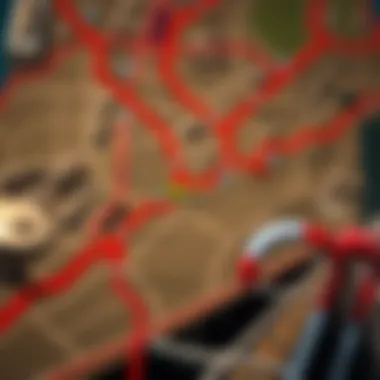
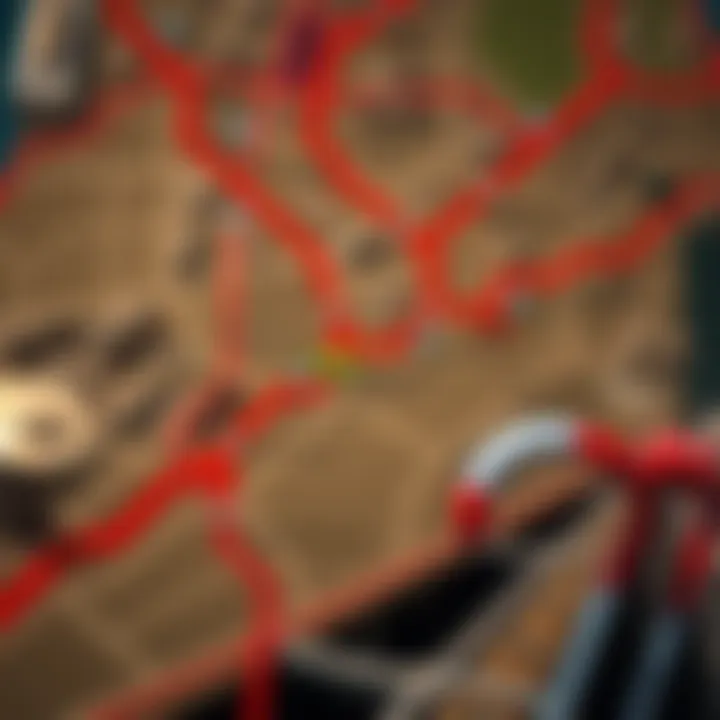
Investment Opportunities in Proximity
Investing in properties close to the Red Line is not just about immediate gains; it’s also about understanding long-term benefits. The strategic placement of metro stations often sets the stage for future developments, making properties nearby prime real estate.
As the Red Line continues to develop, areas adjacent to the stations are likely to experience revitalization and growth. This opens up a plethora of investment opportunities:
- Commercial Spaces: Small businesses like cafes and retail shops are popping up around metro stations. Investors can capitalize on this trend by developing commercial properties that cater to commuters.
- Residential Projects: High-rise residential developments are witnessing a boom as people are on the lookout for modern living spaces close to transport links. Investing in these projects can yield significant returns.
- Mixed-Use Developments: The rise of mixed-use buildings that combine residential, commercial, and recreational spaces makes for attractive investment opportunities that cater to a diverse clientele.
In summary, aligning real estate investments with the location of the Red Line can be a savvy move, offering prospects for appreciation in property values and a steady flow of rental demand.
"Properties near the Red Line will not only promise quick returns but also an enriched lifestyle, making them a win-win for investors in today’s market."
To explore more about the dynamics of real estate in relation to public transportation, you may find the following resources valuable:
Navigating the real estate waters in Dubai can be complex, but with an understanding of the impact of the Red Line, stakeholders are better equipped to make informed decisions.
Future Developments and Extensions
The future developments and extensions of the Red Line of Dubai Metro hold significant implications for the city’s ongoing progress in urban mobility and infrastructural growth. As Dubai continues to evolve into a global metropolis, these enhancements aim not just to accommodate increasing passenger numbers but also to promote sustainable practices and connectivity throughout the city.
Planned Extensions
Several proposed extensions of the Red Line will expand its reach beyond current boundaries. For instance, one notable extension is the proposed route to the Dubai World Central Airport, which, if completed, would provide a seamless transport link for travelers flying in and out of one of the world’s largest airport complexes.
Additionally, another planned extension involves connecting the Red Line to key residential and commercial neighborhoods that remain underserved. This move not only aims to ease congestion, but it also promises to bring economic benefits to areas previously less accessible by public transport.
The anticipated benefits of these extensions are manifold:
- Increased Accessibility: Expanding the network means residents and travelers can access more areas of the city more efficiently.
- Economic Growth: With new stations come business opportunities for local entrepreneurs and increased foot traffic for existing businesses.
- Environmental Impact Reduction: Encouraging the use of public transport through expansions can significantly reduce carbon emissions and traffic congestion on roads.
Ultimately, these planned extensions represent a strategic vision for a well-connected Dubai that prioritizes both convenience and sustainability.
Technological Innovations
The Red Line is not just about physical expansion but also about integrating cutting-edge technology into its operations. Technological innovations play a crucial role in optimizing the user experience, enhancing safety and reliability, and streamlining maintenance processes.
Recent advancements incorporate the use of smart ticketing systems, allowing passengers to pay fares through digital methods like mobile applications, which further increases convenience and decreases the reliance on physical cash. This modern approach also supports efficient crowd management during peak hours.
Moreover, real-time tracking systems provide passengers with up-to-the-minute information about train schedules and delays, promoting transparency and ensuring that riders can plan their journeys more accurately. This innovation can drastically reduce wait times and improve overall satisfaction among users.
Furthermore, innovations in train technology are significantly noteworthy. Newer trains are being designed with energy efficiency in mind, employing lighter materials and regenerative braking systems that help conserve energy and enhance performance.
The future of urban mobility in Dubai stands on the cusp of transformation, enhanced by strategic extensions and groundbreaking technologies.
For further details on transportation in Dubai, you can check the official resources at Dubai's Roads and Transport Authority.
For an overview of the impact of the metro system in urban settings, explore this article on Britannica.
Challenges Faced by the Red Line
The Red Line of Dubai Metro has been hailed as a marvel of modern engineering and urban transit, yet it too faces a range of challenges that must be navigated to ensure its longevity and usefulness. Understanding these challenges is essential for investors, brokers, expatriates, buyers, and researchers interested in the intersection of urban infrastructure and real estate opportunities. The importance of addressing these challenges cannot be overstated, as they impact not only the operational efficiency of the transit system but also the urban environment and overall public perception.
Maintenance and Upgrades
Maintaining the Red Line is no small feat. The line stretches over 52 kilometers and serves numerous stations, all of which require regular maintenance to ensure smooth operations. Scheduled maintainance, including checks on the tracks, trains, and electronic systems, is crucial. A noticeable issue is the wear and tear caused by the arid climate of Dubai—this can accelerate degradation of materials used in the infrastructure.
Furthermore, periodic upgrades are necessitated by advancements in technology and increased passenger demand. For instance, as the population of Dubai grows, the current train frequency must be evaluated. Upgrading the signaling system to improve capacity and ensure faster train movements is paramount. This often involves significant investment, foresight, and coordination, which can pose logistical challenges.
*
"The effectiveness of maintenance directly correlates with passenger satisfaction. Well-kept trains people keep coming back!"
*
Public Perception and Usage
Public perception plays a crucial role in the Red Line's usage and overall reputation. Initially, some residents were hesitant to embrace the metro system, fearing it would not cater to their needs or lifestyle. Over time, however, as awareness grew and word-of-mouth spread, more passengers discovered the convenience it offered. Today, the metro system sees high ridership, especially during peak hours, but challenges remain.
Despite its success, some still perceive it as an overcrowded option during busy times, which can deter potential users. Addressing these misconceptions is vital; understanding their roots can help authorities in marketing strategies or service enhancements, thereby improving ridership.
Key Points for Consideration
- Regular maintenance ensures trains run smoothly and safely; it's not just about fixing things when they break.
- Upgrades must be balanced with budget constraints and anticipated future needs to avoid service disruptions.
- Public engagement and outreach can help shift perceptions and boost station foot traffic.
- A transparent communication strategy about upgrades or disruptions goes a long way in maintaining public trust and satisfaction.
In summary, while the Red Line of Dubai Metro significantly enhances urban mobility, it grapples with various challenges in maintenance, upgrades, and public perception that cannot be ignored. Addressing these challenges effectively will not only maintain the integrity of the system but also enhance the daily lives of those who depend on it.
Environmental Considerations
The integration of the Red Line into Dubai's transit network raises pertinent discussions about environmental considerations. As urban areas continue to expand and the demand for efficient public transport grows, it becomes essential to evaluate how these systems interact with the environment. Emphasizing sustainability isn't just a trend; it’s a necessity for ensuring a livable future. Let's break down the key elements influencing environmental aspects related to the Red Line.
Sustainability Initiatives
A hallmark of the Red Line's development has been its commitment to sustainability. The authorities have rolled out various initiatives aimed at reducing the ecological footprint associated with urban transport. For one, the trains themselves are designed to be energy-efficient, operating on a system that encourages regenerative braking. This technology captures energy when the train slows down, funneling it back into the power grid rather than letting it go to waste.
Moreover, station designs incorporate green architecture principles. Many stations feature energy-efficient cooling systems and are equipped with solar panels, further minimizing their reliance on non-renewable energy sources. The incorporation of vegetative roofs is another impressive initiative that aims to enhance air quality while providing insulation for the buildings.
"Sustainability isn’t just a buzzword; it’s about reshaping how we think about urban living."
The Red Line also promotes the use of electric vehicles by providing designated parking and charging areas at selected stations. Such measures encourage a reduced combustion engine presence within the urban core, thereby promoting cleaner air. This is particularly important in a city like Dubai, where high temperatures and minimal rainfall can exacerbate air quality issues.
Impact on Urban Ecosystems
The establishment of the Red Line has prompted a shift in the urban landscape, which in turn impacts local ecosystems. When looking at the effects on flora and fauna, it’s crucial to consider the balance between development and preservation. As construction took place, extensive environmental assessments were conducted to mitigate adverse impacts, ensuring minimal disruption to existing wildlife.
Furthermore, the Red Line has led to the creation of new green spaces, contributing positively to urban biodiversity. New parks have been established around several stations, providing habitats for various species, and encouraging biodiversity within the city. As a result, the Red Line does not merely serve as a transport corridor; it actively supports urban wildlife and encourages community engagement with nature.
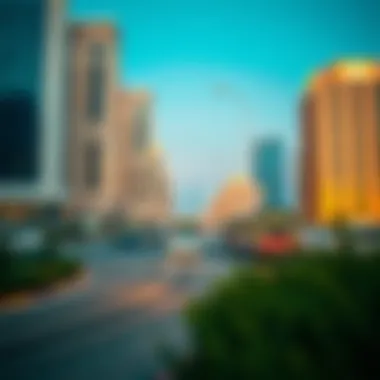
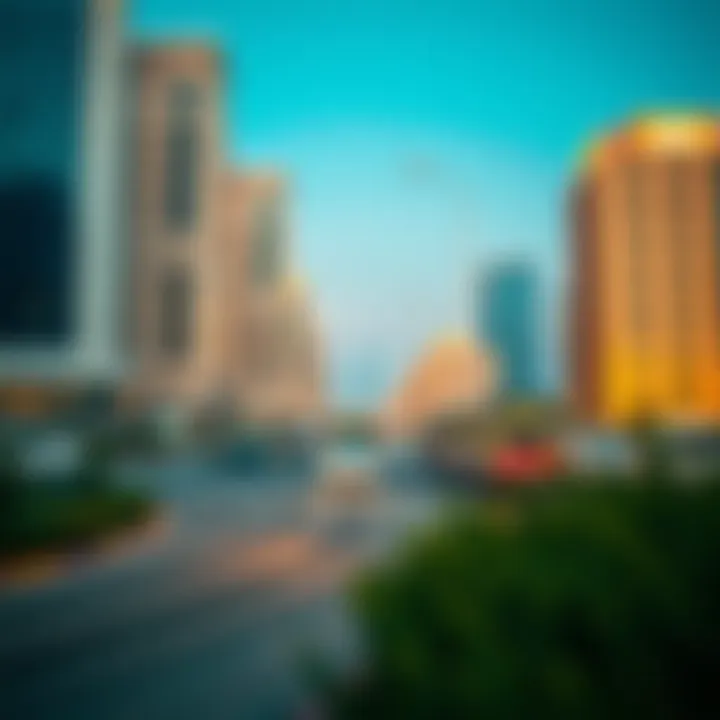
In summary, the environmental considerations surrounding the Red Line of the Dubai Metro are multifaceted. They encompass sustainability initiatives that aim to create an eco-friendly transit system while promoting a balance between urban life and natural ecosystems. The implications for future urban planning can be profound, illustrating a model of integrating transportation with environmental stewardship.
For further insight into sustainability in urban transport, you may explore resources such as Wikipedia or Britannica.
Cultural Influence of the Red Line
The Red Line of the Dubai Metro extends beyond mere infrastructure, serving as a cultural bridge that connects diverse aspects of Dubai’s rich heritage and modern aspirations. This line is not just about getting from point A to point B; it signifies a deeper engagement with art, societal values, and the blending of traditional and contemporary lifestyles. Understanding the Red Line’s cultural influence sheds light on its role in shaping the identity of this vibrant city.
Art and Design Elements
Art plays a vital role in enhancing the aesthetics of public transport systems, and the Red Line is no exception. Each station along the route has been carefully designed with unique artistic elements that reflect not only the modernity of Dubai but also its rich cultural legacy. For instance, the Burjuman Station features intricate tile designs inspired by traditional Islamic patterns, evoking a sense of place and history.
Moreover, various art installations can be found throughout the metro network, showcasing works from local artists and transforming mundane commutes into cultural experiences. Notably, the Union Station features a large mural that narrates the story of Dubai’s evolution from a small fishing village to a sprawling metropolis. This melding of art and architecture does not merely beautify the transit experience; it fosters a sense of belonging among riders, making them stakeholders in the city's cultural narrative.
"Transport isn't just about moving people; it's about creating community and identity."
Integration with Local Culture
The integration of the Red Line with local culture is a testament to Dubai’s vision of a cosmopolitan yet deeply rooted society. The metro facilitates access to traditionally significant neighborhoods, allowing residents and visitors alike to immerse themselves in local customs and festivals. Stations like Dubai Mall not only connect to retail and leisure but also serve as gateways to cultural events, exhibitions, and local markets.
The approach taken by the Red Line goes beyond functionality. It actively engages with the local populace, offering special services during significant cultural events, such as Ramadan and National Day. By promoting accessibility to cultural festivities via enhanced transport services, the Red Line contributes to the city’s collective memory and shared experiences.
This socio-cultural integration is further manifest in community outreach programs initiated by the Dubai Metro authorities, which often include educational initiatives aimed at schools and local businesses. These programs help raise awareness about local heritage while encouraging participation in public transport use.
In summary, the Red Line serves as both a physical transit corridor and a conduit for cultural exchange, reflecting Dubai’s ethos of progress while honoring its historical roots. Understanding the cultural influence of the Red Line reveals insights into how infrastructure can foster a sense of community while promoting broader societal values.
User Experiences and Testimonials
User experiences and testimonials serve as crucial components in understanding the overall success and impact of the Dubai Metro Red Line. They provide insights not only into the operational aspects of the transit system but also into personal narratives that reflect how the line meets the varying needs of its users. Such testimonies contribute significantly to a more relatable and human perspective on what can often be looked at purely through technical or economic lenses.
Passenger Feedback
Passenger feedback is fundamental in evaluating the user satisfaction levels and the efficiency of the Red Line. Riders often share candid insights into their journeys, helping paint a more vivid picture of day-to-day operations. The feedback collected ranges from comments about punctuality and cleanliness to the conditions of the trains and the helpfulness of staff.
Many passengers appreciate the timeliness of the Red Line, noting how it often runs like clockwork, which is a relief for commuters in a busy city like Dubai. Comments often reveal a sense of security at stations, where many find the presence of security personnel reassuring.
Moreover, the innovative ticketing system receives both praise and critique. Many users appreciate the ease of use of the Nol card. Still, some express a desire for more transparent information on pricing, especially for tourists who may be unfamiliar with local systems.
"The Red Line makes life easier! I can hop on a train without worrying about traffic jams. It's particularly nice when I need to reach the Downtown area swiftly."
– An expatriate living in Dubai.
Case Studies of Usage
Analyzing case studies of usage provides deeper insight into how specific demographics utilize the Red Line. For instance, consider the usage patterns among workers commuting to and from the Dubai International Financial Centre. Many professionals there rely on the metro for daily transportation, often leading to packed trains during peak hours. Surveys show a strong preference among this group for the connectivity offered by the Red Line, which allows easy access to key business areas.
Similarly, family usage is also noteworthy. A recent family-oriented survey highlighted how the Red Line connects neighborhoods to family-friendly destinations like shopping malls and parks. Parenting groups echo the importance of the Red Line, especially praising the services offered, like elevators in stations for strollers.
Another compelling case study involves international visitors. They frequently utilize the Red Line to explore Dubai. Guided feedback suggests that the metro serves as a vital resource for tourists eager to visit iconic sites. Many expressed surprise at how user-friendly the navigation could be, despite initial anxieties about unfamiliarity with the transit systems.
The combination of passenger feedback and specific case studies illustrates a multi-faceted view of the Red Line’s performance, reflecting not just technical efficiency but also the emotional narrative woven through the experience of its users. By looking into these aspects, we gain valuable insights into how the Red Line of Dubai Metro is not just a transit line but a vessel for daily stories and experiences that shape the urban fabric.
Comparative Analysis with Other Transport Systems
Importance of Comparative Analysis
Comparative analysis serves as a vital tool in assessing how the Red Line of Dubai Metro stands in relation to other transport means, not just within the region but across the globe. For investors, brokers, expatriates, and researchers alike, understanding such distinctions can lead to informed decisions regarding mobility and real estate investments. The Red Line is not merely an isolated feature of Dubai's infrastructure; it reflects broader trends in urban transport systems worldwide. By studying its operational efficiency and passenger satisfaction in a comparative context, various stakeholders can glean insights into potential areas of enhancement and noteworthy practices.
International Metro Comparisons
When one looks globally, metropolitans like the London Underground, New York City Subway, and Tokyo Metro come to mind, each with its peculiarities and set of strengths.
- London Underground: Widely regarded as the first underground railway, it boasts a vast network that extends far beyond the city center. The sheer size can be overwhelming, yet it remains efficient with a respectable punctuality rate.
- New York City Subway: Known for its round-the-clock service, it caters to a high volume of ridership, presenting challenges in maintenance and operational efficiency. The system is often critiqued for its aging infrastructure.
- Tokyo Metro: Renowned for its punctuality and cleanliness, this system stands as a benchmark for efficiency. The intricate network allows for seamless transfers across multiple lines, which could serve as an inspiration for Dubai as it considers future expansions.
In comparison, the Red Line is unique in its design and operation. Opened in 2010, it is modern and technologically advanced, unlike some older systems that battle with outdated infrastructure. The focus on user experience, coupled with a growing network, allows the Red Line to compete strongly against these established systems.
Efficiency Comparisons
Efficiency is measured in various ways, from punctuality to the ease of use. Different metrics paint various narratives.
- Punctuality: The Red Line, with its automated train system, achieves a high level of punctuality. In contrast, others like the New York Subway suffer delays due to factors such as aging trains and infrastructure issues.
- Capacity: When it comes to passenger capacity, the Tokyo Metro leads the pack, continuously working to manage the crowds effectively. The Red Line, while efficient for Dubai’s current needs, still has room for growth in managing peak times.
- Fare System: The Red Line's integrated fare system simplifies ticketing, making it user-friendly. This is crucial in enhancing the commuter experience, particularly for expatriates who may find different systems challenging to navigate. Comparatively, other metro systems often have convoluted fare structures, which may deter use.
Though the Red Line faces its own challenges, such as expansion and growth management, it is positioned to learn from these global examples. Understanding other systems allows Dubai Metro to adapt and thrive, ensuring that its service remains competitive and efficient.
The comparative analysis sheds light on the pathways Dubai's Red Line could take towards optimizations, emphasizing both bright spots and areas needing attention.
In summary, a careful look at transport systems around the world not only highlights the strengths of the Red Line but also identifies opportunities for continuous improvement. As this system evolves, it can draw lessons from both the triumphs and stumbling blocks of its international counterparts.
Summary of Key Insights
The Red Line of Dubai Metro is not just a mode of transport; it is a linchpin of urban development, influencing various sectors of the city’s economy and lifestyle. This summary captures the pivotal insights gleaned from the exploration of the Red Line, emphasizing its multifaceted impact and the vital role it plays in shaping Dubai's future.
Essential Takeaways
- Urban Mobility: The Red Line has revolutionized public transport in Dubai, making commuting efficient and less stressful. With a route that spans key areas of the city, it enhances connectivity, enabling seamless travel for daily commuters and tourists alike.
- Economic Catalyst: The presence of the Red Line directly correlates to an increase in property values in surrounding neighborhoods. Investors and real estate brokers should take note of this trend, as proximity to metro stations can considerably enhance marketability and return on investment for properties.
- Environmental Impact: As a sustainable transport option, the Red Line contributes to reducing carbon footprints by mitigating reliance on private vehicles. This ecological consideration makes it an essential part of Dubai's plans for a greener, more sustainable future.
- Future Developments: Ongoing and planned expansions signal a commitment to improving and extending this infrastructure. For those keeping an eye on investment opportunities, these expansions may unlock new markets and locales for development.
- Cultural Integration: The architectural elements and artwork found in the stations showcase Dubai's dedication to preserving and promoting its cultural identity. This aspect makes the Red Line not only a practical transit solution but also a cultural journey in itself.
- Public Sentiment: User feedback highlights both praise for the system's efficiency and areas for improvement. Understanding passenger experiences can inform further enhancements, ensuring the Red Line continues to meet the needs of its users.
"The transport system is a mirror reflecting the city’s pulse. The Red Line is an intricate vein that enhances not just access but experience in Dubai."
Epilogue
As this article wraps up, it becomes clear just how significant the Red Line of the Dubai Metro is. It stands not merely as a mode of transportation but as a catalyst for economic, social, and cultural development within the city. The concluding thoughts on the future of the Red Line are particularly compelling, with various avenues for expansion and enhancement that promise to add more value to this essential transit system.
The Future of the Red Line
The future of the Red Line invites us to consider not just its expansion but the ongoing evolution of urban transport itself in a rapidly changing environment. Plans are in the pipeline for potential extensions that reach deeper into Dubai, connecting more communities and making the network even more robust. This forward-thinking approach isn’t just about laying down new tracks; it’s about integrating cutting-edge technology, promoting sustainability, and improving service efficiency.
Among anticipated advancements, technology integration stands out. Smart ticketing systems and real-time tracking might become commonplace, enhancing convenience for users. Such innovations also contribute to better crowd management, ensuring a seamless commuting experience. In tandem with this, the introduction of green initiatives hints at a broader commitment to reducing the environmental footprint. To put it plainly, the Red Line isn’t just focused on moving people; it is embracing the future of urban living where convenience and sustainability walk hand in hand.
In summation, the Red Line serves as a blueprint for how metropolitans can evolve. With potential benefits stretching across demographics—from investors eyeing real estate near stations to expatriates seeking reliable commuting options—the Red Line is positioned to maintain its central role in Dubai’s narrative. Understanding its trajectory not only informs us about travel in the city but also highlights the interconnected nature of urban development, social change, and economic opportunity.
"Mobility is not just about distance, but the connections it creates."
Engagement with future developments of the Red Line can provide invaluable insights for anyone involved in Dubai's dynamic landscape—from brokers crafting investment strategies to researchers analyzing urban trends. As the dust settles on current projects, the horizon looks promising for enhancing urban life through thoughtful transportation planning.

